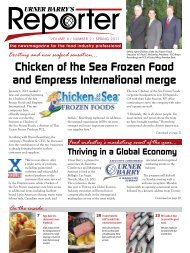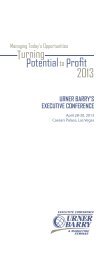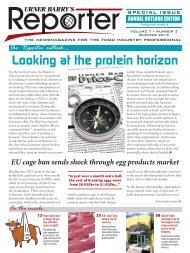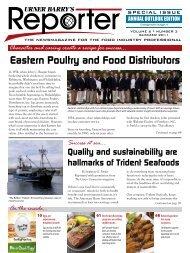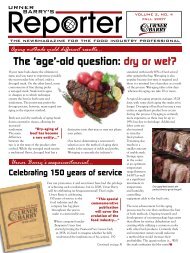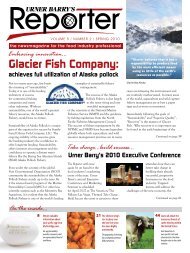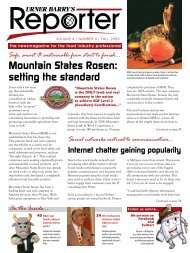Cooper Farms: - Urner Barry Publications, Inc.
Cooper Farms: - Urner Barry Publications, Inc.
Cooper Farms: - Urner Barry Publications, Inc.
Create successful ePaper yourself
Turn your PDF publications into a flip-book with our unique Google optimized e-Paper software.
Right: High yields are crucial in the fish<br />
business—the higher the yield, the more<br />
money can be made.<br />
Below: Whole salmon. Much of today’s<br />
salmon is filleted by machine; however,<br />
Fusco does all his salmon filleting by hand.<br />
the belly area, and repeated the process on<br />
the bottom side of the fish yielding two<br />
fillets. He explained that the fillet meat of<br />
this type of fluke<br />
yielded about<br />
“The<br />
47% meat from yield was<br />
a wholefish. He explained to<br />
and Marty both<br />
the Reporter<br />
stressed that yield<br />
as the<br />
(the percentage of<br />
meat weight that percentage<br />
comes from each of meat<br />
fish) is crucial in weight that<br />
the fish business comes from<br />
as the higher the each fish.”<br />
yield, the more<br />
money can be made. Marty interjected<br />
that in tough economic times, like what<br />
most businesses have experienced of<br />
late, it is critical to get the highest yields<br />
possible and every tiny piece of meat<br />
that is missed, can affect the bottom<br />
dollar. Marty Bailey boasted about the<br />
magnificent yields that Fusco gets from<br />
every species he fillets. Bailey also praised<br />
Fusco’s abilitiy at being able to be good at<br />
filleting a variety of species.<br />
demonstration by filleting<br />
salmon, and explained that<br />
much of today’s salmon is<br />
filleted by machine; however,<br />
he does all his salmon filleting<br />
by hand. He began by laying<br />
the fish on a clam net to<br />
prevent it from slipping. The<br />
process that Fusco describes as<br />
“riding the bone” appears to<br />
be similar to his previous demonstration.<br />
What differed in this process was that he<br />
removed all the pinbones from the center<br />
of each fillet by using needle-nose pliers.<br />
Fusco explained that customers prefer his<br />
method over machinery because he does<br />
not make any noticeable alterations to the<br />
meat. The Reporter was told that the yield<br />
of a gutted salmon on average was<br />
76%. Fusco continued with gray<br />
tilefish, Silk red snapper, cod, and<br />
swordfish. Each species had certain<br />
intricacies that only a master such<br />
as Jimmy would be able to quickly<br />
identify. Bailey explained that it is<br />
rare to find someone like Fusco who<br />
can successfully fillet many species of<br />
fish and achieve high meat yields on all of<br />
them. Fusco said, referring to filleting, “It’s<br />
an art, it’s definitely an art.”<br />
Collectively, Bailey and Fusco were able<br />
to rattle off the origins of each fish,<br />
the yield percentage of meat from each<br />
species and details about the texture,<br />
flavor and uses of each. The business<br />
could not be named more appropriately<br />
because the tremendous pride displayed<br />
by both gentlemen was quite apparent and<br />
refreshing.<br />
To view the detailed demonstrations of<br />
Jimmy filleting fish, visit our interview<br />
on YouTube http://www.youtube.com/<br />
watchv=9LVpbQRiyCY.UB<br />
Fusco then demonstrated the filleting of<br />
halibut, a much larger flatfish. For this<br />
species he used a much larger knife. He<br />
also explained that when he hits the spine<br />
bones in the center of the fillet, he tilts his<br />
knife upward and then over and down to<br />
get as close to the bone as possible without<br />
leaving any valuable meat behind. Halibut<br />
arrives at their location, headed and<br />
gutted and Bailey reported that Fusco’s<br />
yield is about 70%. Fusco continued his<br />
www.seafoodbysigma.com<br />
VOL. 6, NO. 1 / WINTER 2011 / URNER BARRY’S REPORTER • 23



